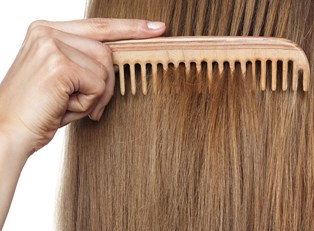If you suffer from oily hair that just doesn't seem to stay "clean" very long even after you've washed it, you may be using the wrong type of shampoo. In fact, your shampoo may be making the problem worse. With so many products on the market making claims about being "the best" for oily hair, how do you know which work? Following these five tips will help your hair go from greasy to great.
- Consider your scalp.
The term "oily hair" is actually a misnomer; hair does not secrete oil, but your scalp does. When choosing the right shampoo, you're actually looking for a product to treat both your scalp and hair.
Sebum is a specialized type of oil glands in your scalp and face produce to protect and revitalize skin. When your scalp produces the right amount of sebum, your hair and skin will look radiant and healthy. Unfortunately, too much sebum can make your hair appear dirty, oily and matted. Teenagers especially may produce too much sebum due to hormone changes. - Avoid certain ingredients.
Have you ever looked at the ingredient list on your shampoo? Some ingredients can actually make your oily hair look more dirty, dull, and heavy rather than cleaning and restoring it. Worse yet, these ingredients can also cause dandruff if your scalp is especially sensitive.
When selecting a shampoo, avoid any product with types of alcohol, silicone, polyquaternium, parabens, chloride, or sodium sulfates. Additionally, some "oily hair" treatments may be too strong for everyday use and can strip your hair of nutrients. Choose a gentle, clarifying shampoo designed for oily hair instead. - Consider your hair texture.
Not all hair textures and shampoos mix. If your hair is curly, for example, using the wrong oily hair treatment can leave it frizzy and dry. Likewise, if you have straight or thick hair, you may want to avoid shampoos designed to "tame" curly or frizzy hair; they can leave your locks looking dull and flat. If you color treat your hair, be sure to choose clarifying shampoo that is specially designed to be gentle on dyed locks. - Choose shampoos with natural ingredients.
Natural ingredients can help your scalp produce less sebum while protecting and revitalizing your hair. Avoid any type of shampoo with a thickening agent, which can make oily hair problems worse. Certain types of shampoos which use natural ingredients are often gentle enough to use for regular washing. Look for a clear, "light-weight" type of shampoo that contains citrus extract, green tea, tea tree, or astringent herbs such as basil, thyme, and rosemary. - Wash hair correctly.
It's important to wash your hair thoroughly and correctly so the shampoo of your choice can work as intended. Remember, shampoo treats your scalp as well as your hair, so lather well and then let the shampoo "sit" in your hair and on the scalp for about five minutes before rinsing. When applying conditioner, start at the ends of your hair first, then gently work upward to the hairline. Avoid letting conditioner come in contact with the scalp. Shampoo is a cleanser, while conditioner treats only the hair, so it has no need to come in contact with skin.




